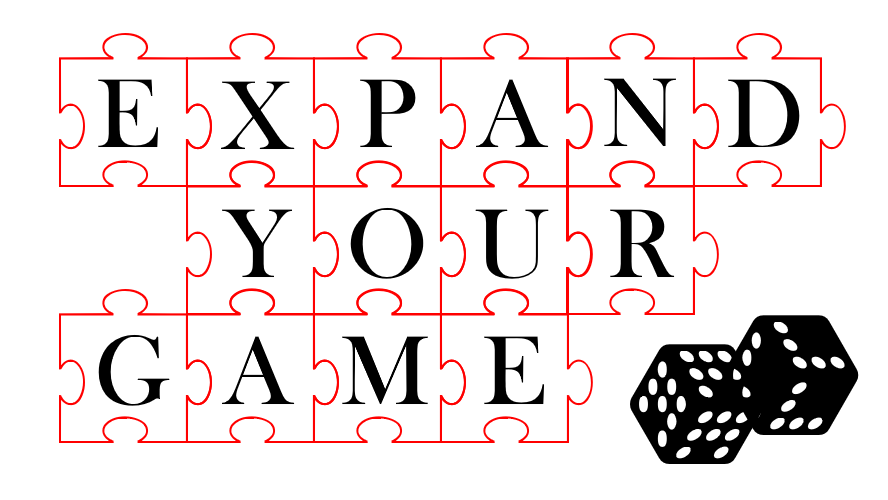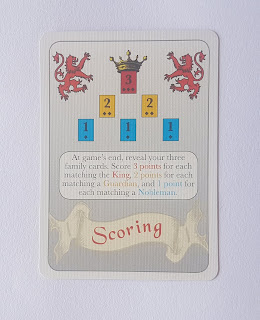Kings Kilt: Review
Information:
Mechanics: Grid Movement, Hidden Information, Bluffing
Player Age: 8+
Player Count: 1 - 4 Players
Time to Play: 30 - 45 Minutes
Release Year: 2015
Game Designer: Gord Hamilton
Game Artist: Tomasz Larek
Publisher: Eagle-Gryphon Games
BGG Weight: 1.63
Disclaimer: A review copy for the game was provided by the publisher.
Player Age: 8+
Release Year: 2015
Game Designer: Gord Hamilton
Game Artist: Tomasz Larek
Publisher: Eagle-Gryphon Games
BGG Weight: 1.63Disclaimer: A review copy for the game was provided by the publisher.
Objective:
Through ascending the Scottish hierarchy you want to position your clans of power at the top, and as close to the top, of the pyramid. Be careful though, as cards can be played from an opponents hand to betray and remove clan members who are already at a good placement on the pyramid.Set Up:
Family Cards:
- Take 1 card of each of the 8 clans, shuffle and deal each player 2 of these clans. This way each player begins with 2 unique clans.- Deal each player a random clan from the deck. If any player has two of the same clan members then discard that card and redraw another until each player has 3 unique clans, creating their hand of family cards (these will score for each player at the end of the game).
Influence Cards:
- Reshuffle the clan deck and deal five cards to each player in a 2 or 3 player game, or four cards in a 4 player game.- These are your influence cards; keep these separate from your family cards as these will be used for backstabbing later on.
Clan Member Draw Pile:
- Shuffle the clan cards then place the 16 clan leaders on top of the deck.- The clan leader cards will have each clans appearing twice. This is to make sure that there is an even spread of the clans at the start of the game.
Pyramid Base and Reminder Cards:
- Deal 6 cards from the draw pile face up as a base of the pyramid. Make sure to leave a full card width between the cards. This pyramid will continue to grow upward throughout the game so make sure to leave enough table space.- Place the scoring reminder card to one side where the top of the pyramid should be. Place the guardian reminder below that card, and place the nobleman reminder below the guardian. - The player with the closest lineage to the Scottish crown will be the first player.
How to Play:
In a quest to place a clan at the top of the Scottish hierarchy, you will either advance a clan member or betray another clan card.Advancing a clan member card:
To advance a clan member you will move a clan card upwards diagonally so it reaches the next level of the pyramid. When this occurs the clan card requires two cards to be below it for support.When this occurs the space below the newly moved card will be left vacant and will need to be filled. This occurs by either moving one of the two cards below the empty spot upwards, creating new empty spaces that need to be filled. This continues to occur until the empty space reaches the bottom level of the pyramid which will then be filled with the top card of the deck. This can lead to five spots being filled after just one movement.
Using influence to betray a clan card:
This is when the influence cards you gained at the start of the game become useful. When influencing a clan card into betrayal, the player will discard an influence card and eliminate a clan card that neighbours the chosen card. The chosen card is now moved into the vacant space and the player will fill in the empty spaces like normal.On the top three rows the influence card has to match the clan member that is about to do the betraying, whereas in any of the other rows, any influence can be used. Be careful though as the influence cards are not replaced throughout the game so you must choose when to use them wisely so that your family clan can rise to the top of the pyramid.
Nobleman and Guardian Reminders:
Whenever the first player causes a clan member to ascend to either of these rows (The top three rows) a special effect will occur resulting in family cards being revealed from a player’s hand. In a two player game the player that first moves a clan card into one of these rows will reveal all but one of the family cards for the remainder of the game. In a game with more players, every player but the player who moved into the row and the player to their right will reveal one of their family cards face up for the rest of the game.Full Pyramid:
Once a clan card has reached the top level of the pyramid (king), players can no longer advance by normal means and have to either use influenced betrayal, or pass their turn. If they pass, they will have no more actions for the remainder of the game and once every player passes the scoring will commence.Scoring:
Every player will reveal their family cards and score three points if the king matches one of their clans; two points for any of their clan members in the second row; and one point for any of their clans in the third row. Whomever has the most points is the victor and has successfully influenced the crowning of the noble families in Scotland.Final thoughts:
Pros:- Choosing when and how to play your influence is very crucial to winning the game, especially since it is the main form of clan advancement during late game.
- Trying to hide your family clan and identify your opponents’ adds an interesting bluffing side to the game.
- It is an interesting filler game that can be taught to anyone due to its easy to learn rules.
Cons:
- The art is functional but doesn't add much flavour to the game.
'Kings Kilt' reminds me of one of the classic card games. It is easy to learn on the surface but the more you play, the more you notice when players are unknowingly revealing their families or when it is best to successfully influence. When another player finds out your family you now have a target on your clan and they will go out of their way to eliminate them from the top three rows, so you have to be careful and try to outmanoeuvre and out-bluff your opponents. Kings Kilt is one of those games I would introduce to players that are unfamiliar with today's board game hobby, but who grew up on classic card games. It is easy to learn and after you have played it once you will want to do better and will instantly want to play again.
Click...feed the addiction:
Eagle-Gryphon GamesKing Kilt on BGG
Expand Your Game Facebook page
Expand Your Game Instagram







Comments
Post a Comment